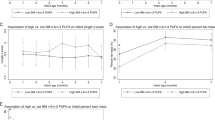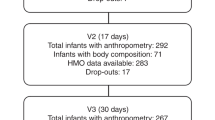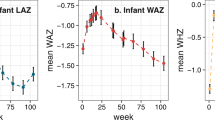Abstract
Objective:
To determine the impact of maternal obesity on breastmilk composition.
Study Design:
Breastmilk and food records from 21 lean and 21 obese women who delivered full-term infants were analyzed at 2 months post-partum. Infant growth and adiposity were measured at birth and 2 months of age.
Result:
Breastmilk from obese mothers had higher omega-6 to omega-3 fatty acid ratio and lower concentrations of docosahexaenoic acid, eicosapentaenoic acid, docasapentaenoic acid and lutein compared with lean mothers (P<0.05), which were strongly associated with maternal body mass index. Breastmilk saturated fatty acid and monounsaturated fatty acid concentrations were positively associated with maternal dietary inflammation, as measured by dietary inflammatory index. There were no differences in infant growth measurements.
Conclusion:
Breastmilk from obese mothers has a pro-inflammatory fatty acid profile and decreased concentrations of fatty acids and carotenoids that have been shown to have a critical role in early visual and neurodevelopment. Studies are needed to determine the link between these early-life influences and subsequent cardiometabolic and neurodevelopmental outcomes.
This is a preview of subscription content, access via your institution
Access options
Subscribe to this journal
Receive 12 print issues and online access
$259.00 per year
only $21.58 per issue
Buy this article
- Purchase on Springer Link
- Instant access to full article PDF
Prices may be subject to local taxes which are calculated during checkout

Similar content being viewed by others
References
Simmons R . Perinatal programming of obesity. Semin Perinatol 2008; 32: 371–374.
Center for Disease Control and Prevention. Progress in increasing breastfeeding and reducing racial/ethnic differences—United States, 2000-2008 births. Morb Mortal Wkly Rep 2013; 62: 77–80.
Fisher SC, Kim SY, Sharma AJ, Rochat R, Morrow B . Is obesity still increasing among pregnant women? Prepregnancy obesity trends in 20 states, 2003-2009. Prev Med 2013; 56: 372–378.
Underwood BA . Maternal vitamin A status and its importance in infancy and early childhood. Am J Clin Nutr 1994; 69 (Suppl): 517S–524S.
Sen S, Iyer C, Meydani SN . Obesity during pregnancy alters maternal oxidant balance and micronutrient status. J Perinatol 2014; 34: 105–111.
Storck Lindholm E, Strandvik B, Altman D, Moller A, Palme Kilander C . Different fatty acid pattern in breast milk of obese compared to normal-weight mothers. Prostaglandins Leukot Essent Fatty Acids 2013; 88: 211–217.
Fujimori M, Franca EL, Fiorin V, Morais TC, Honorio-Franca AC, de Abreu LC . Changes in the biochemical and immunological components of serum and colostrum of overweight and obese mothers. BMC Pregnancy Childbirth 2015; 15: 166.
Collado MC, Laitinen K, Salminen S, Isolauri E . Maternal weight and excessive weight gain during pregnancy modify the immunomodulatory potential of breast milk. Pediatr Res 2012; 72: 77–85.
Oben JA, Mouralidarane A, Samuelsson AM, Matthews PJ, Morgan ML, McKee C et al. Maternal obesity during pregnancy and lactation programs the development of offspring non-alocholic fatty liver disease in mice. J Hepatol 2010; 52: 913–920.
Grant WF, Gillingham MB, Batra AK, Fewkes NM, Comstock SM, Takahashi D et al. Maternal high fat diet is associated with decreased plasma n-3 fatty acids and fetal hepatic apoptosis in nonhuman primates. PLoS One 2011; 6: e17261.
Scopesi F, Ciangherotti S, Laniteri PB, Risso D, Bertini I, Campone F et al. Maternal dietary PUFAs intake and human milk content relationships during the first month of lactation. Clin Nutr 2001; 20: 393–397.
McCrory MA, Fuss PJ, McCallum JE, Yao M, Vinken AG, Hays NP et al. Dietary variety within food groups: association with energy intake and body fatness in men and women. Am J Clin Nutr 1999; 69: 440–470.
Shivappa N, Steck SE, Hurley TG, Hussey JR, Ma Y, Ockene IS et al. A population-based dietary inflammatory index predicts levels of C-reactive protein in the Seasonal Variation of Blood Cholesterol Study (SEASONS). Public Health Nutr 2014; 17 (8): 1825–1833.
Tabung FK, Steck SE, Zhang J, Ma Y, Liese AD, Agalliu I et al. Construct validation of the dietary inflammatory index among postmenopausal women. Ann Epidemiol 2015; 25 (6): 398–405.
Shivappa N, Hebert JR, Rietzschel ER, De Buyzere ML, Langlois M, Debruyne E et al. Associations between dietary inflammatory index and inflammatory markers in the Asklepios Study. Br J Nutr 2015; 113 (4): 665–671.
Barker FM 2nd, Snodderly DM, Johnson EJ, Schalch W, Koepcke W, Gerss J et al. Nutritional manipulation of primate retinas, V: effects of lutein, zeaxanthin, and n-3 fatty acids on retinal sensitivity to blue-light-induced damage. Invest Ophthalmol Vis Sci 2011; 52: 3934–3942.
Gillman MW, Rifas-Shiman SL, Camargo CA Jr, Berkey CS, Frazier AL, Rockett HR et al. Risk of overweight among adolescents who were breastfed as infants. JAMA 2001; 285: 2461–2467.
Lucas A, Sarson DL, Blackburn AM, Adrian TE, Aynsley-Green A, Bloom SR . Breast vs bottle: endocrine responses are different with formula feeding. Lancet 1980; 1: 1267–1269.
Yang LG, Song ZX, Yin H, Wang YY, Shu GF, Lu HX et al. Low n-6/n-3 PUFA ratio improves lipid metabolism, inflammation, oxidative stress and endothelial function in rats using plant oils as n-3 fatty acid source. Lipids 2015 (e-pub ahead of print).
Pedersen L, Lauritzen L, Brasholt M, Buhl T, Bisgaard H . Polyunsaturated fatty acid content of mother’s milk is associated with childhood body composition. Pediatr Res 2012; 72: 631–636.
Wang Y, Huang F . N-3 polyunsaturated fatty acids and inflammation in obesity: local effect and systemic benefit. Biomed Res Int 2015; 2015: 581469.
Schmelzle HR, Fusch C . Body fat in neonates and young infants: validation of skinfold thickness versus dual-energy X-ray absorptiometry. Am J Clin Nutr 2002; 76: 1096–1100.
Shivappa N, Steck SE, Hurley TG, Hussey JR, Hebert JR . Designing and developing a literature-derived, population-based dietary inflammatory index. Public Health Nutr 2014; 17: 1689–1696.
Bieri JG, Tolliver TJ, Catignani GL . Simultaneous determination of alpha-tocopherol and retinol in plasma or red cells by high pressure liquid chromatography. Am J Clin Nutr 1979; 32: 2143–2149.
Babson AL . The IMMULITE assay tube: a new approach to heterogeneous ligand assay. Clin Chem 1991; 37: 1521–1522.
Hart GR, Furniss JL, Laurie D, Durham SK . Measurement of vitamin D status: background, clinical use, and methodologies. Clin Lab 2006; 52: 335–343.
Horne DW, Patterson D . Lactobacillus casei microbiological assay of folic acid derivatives in 96-well microtiter plates. Clin Chem 1988; 34: 2357–2359.
Giuliano AR, Neilson EM, Kelly BE, Canfield LM . Simultaneous quantitation and separation of carotenoids and retinol in human milk by high-performance liquid chromatography. Methods Enzymol 1992; 213: 391–399.
Yeum KJ, dos Anjos Ferreira AL, Smith D, Krinsky NI, Russell RM . The effect of alpha-tocopherol on the oxidative cleavage of beta-carotene. Free Radic Biol Med 2000; 29: 105–114.
Folch J, Lees M, Sloane-Stanley GH . A simple method for the isolation and purification of total lipides from animal tissues. J Biol Chem 1957; 226: 497–509.
Matthan NR, Ip B, Resteghini N, Ausman LM, Lichtenstin AH . Long-term fatty acid stability in human serum cholesteryl ester, triglyceride, and phospholipid fractions. J Lipid Res 2010; 51: 2826–2832.
Rodriguez-Cruz M, Tovar AR, Palacios-Gonzalez B, Del Prado M, Torres N . Synthesis of long-chain polyunsaturated fatty acids in lactating mammary gland: role of Delta5 and Delta6 desaturases, SREBP-1, PPAR-alpha, and PGC-1. J Lipid Res 2006; 47: 553–560.
Patterson E, Wall R, Fitzgerald GF, Ross RP, Stanston C . Health implications of high dietary omega-6 polyunsaturated fatty acids. J Nutr Metab 2012; 2012: 539426.
Scoditti E, Capurso C, Capurso A, Massaro M . Vascular effects of the Mediterranean diet-part II: role of omega-3 fatty acids and olive oil polyphenols. Vascul Pharmacol 2014; 63: 127–134.
Plagemann A, Harder T, Franke K, Kohlhoff R . Long-term impact of neonatal breast-feeding on body weight and glucose tolerance in children of diabetic mothers. Diabetes Care 2002; 25: 16–22.
Fields DA, Demerath EW . Relationship of insulin, glucose, leptin, IL-6 and TNF-α in human breast milk with infant growth and body composition. Pediatr Obes 2012; 7: 304–312.
Taveras EM, Rifas-Shiman SL, Sherry B, Oken E, Haines J, Kleinman K et al. Crossing growth percentiles in infancy and risk of obesity in childhood. Arch Pediatr Adolesc Med 2011; 165: 993–998.
Neuringer M, Connor WE, Lin DS, Barstad L, Luck S . Biochemical and functional effects of prenatal and postnatal omega 3 fatty acid deficiency on retina and brain in rhesus monkeys. Proc Natl Acad Sci USA 1986; 83: 4021–4025.
Innis SM . Fatty acids and early human development. Early Hum Dev 2007; 83: 761–766.
Mulder KA, King DJ, Innis SM . Omega-3 fatty acid deficiency in infants before birth identified using a randomized trial of maternal DHA supplementation in pregnancy. PLoS One 2014; 10: e83764.
Bovier ER, Lewis RD, Hammond BR Jr . The relationship between lutein and zeaxanthin status and body fat. Nutrients 2013; 5: 750–757.
Amir LH, Donath S . A systematic review of maternal obesity and breastfeeding intention, initiation and duration. BMC Pregnancy Childbirth 2007; 7: 9.
Tully KP, Ball HL . Maternal accounts of their breastfeeding intent and early challenges after cesarean childbirth. Midwifery 2014; 30: 712–719.
Hennigar SR, Velasquez V, Kelleher SL . Obesity-induced inflammation is associated with alterations in subcellular zinc pools and premature mammary gland involution in lactating mice. J Nutr 2015; 145: 1888–2005.
Braam LA, Ocké MC, Bueno-de-Mesquita HB, Seidell JC . Determinants of obesity-related underreporting of energy intake. Am J Epidemiol 1998; 147: 1081–1086.
AAP, ACOG Breastfeeding Handbook for Physicians. American Academy of Pediatrics and American College of Obstetricians and Gynecologists: Washington, DC, USA, 2006.
Acknowledgements
This work is supported by Tufts Medical Center Department of Pediatrics, Susan Saltonstall Foundation Grant Program, Pilot Project Award 2012, NICHD K23HD074648 (SS), NIDDK R44DK103377 (NS, MDW and JRH).
Author information
Authors and Affiliations
Corresponding author
Ethics declarations
Competing interests
JRH owns controlling interest in Connecting Health Innovations LLC (CHI), a company planning to license the right to his invention of the dietary inflammatory index (DII) from the University of South Carolina to develop computer and smart phone applications for patient counseling and dietary intervention in clinical settings. MDW and NS are employees of CHI. The subject matter of this paper will not have any direct bearing on that work, nor has that activity exerted any influence on this project. The remaining authors declare no conflict of interest.
Rights and permissions
About this article
Cite this article
Panagos, P., Vishwanathan, R., Penfield-Cyr, A. et al. Breastmilk from obese mothers has pro-inflammatory properties and decreased neuroprotective factors. J Perinatol 36, 284–290 (2016). https://doi.org/10.1038/jp.2015.199
Received:
Revised:
Accepted:
Published:
Issue Date:
DOI: https://doi.org/10.1038/jp.2015.199
This article is cited by
-
Longitudinal analysis of carotenoid content in preterm human milk
European Journal of Pediatrics (2024)
-
Maternal weight, gut microbiota, and the association with early childhood behavior: the PREOBE follow-up study
Child and Adolescent Psychiatry and Mental Health (2023)
-
Calcium, zinc, and vitamin D in breast milk: a systematic review and meta-analysis
International Breastfeeding Journal (2023)
-
Maternal pre-pregnancy BMI associates with neonate local and distal functional connectivity of the left superior frontal gyrus
Scientific Reports (2021)
-
The impact of maternal obesity and breast milk inflammation on developmental programming of infant growth
European Journal of Clinical Nutrition (2021)



